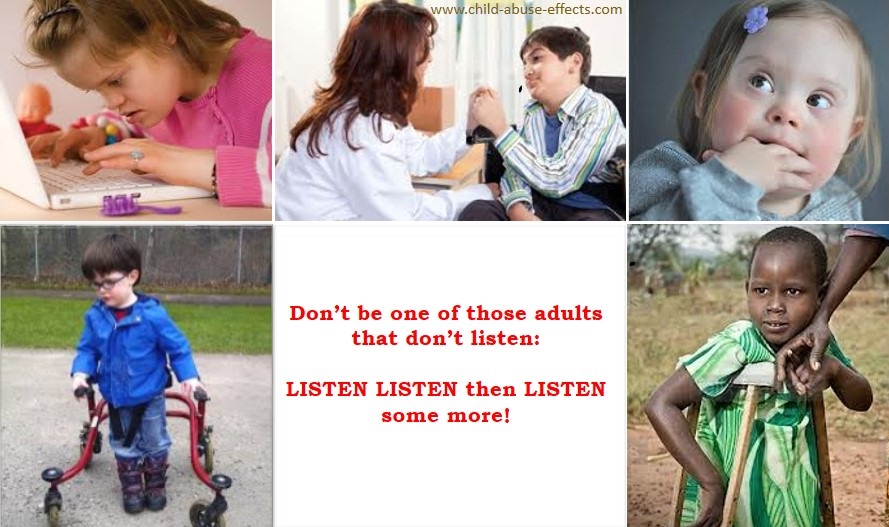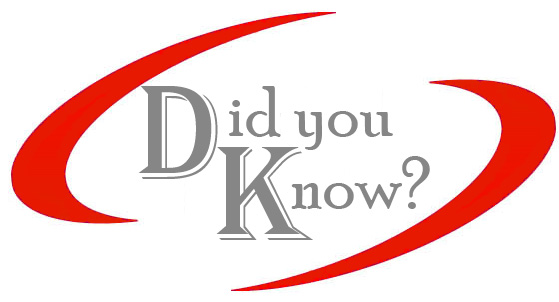Victims with Disability

Societal myths and lack of protection services put sexual abuse victims with disability at an increased risk for ongoing sexual abuse. The disabilities these children face vary widely, and can be physical, medical or neurological.
These children and youth may:
» require the use of crutches or a
wheelchair
» be blind
» have a speech or hearing
disability
The disability might not even be visible, for example:
» heart conditions
» diabetes
» epilepsy
» dyslexia or other learning disabilities
|
Even when children and youth with disabilities do disclose sexual abuse or if they show signs of abuse, disclosures and suspicions are often brushed aside because they are labeled: » having "behaviour problems" |
|
 |
The Canadian Institute of Child Health Survey, conducted in 1996-97, revealed that there were 564,575 children and youth with disability or 7.7% of the Canadian child/youth population. Male children from birth to 9 years of age had the highest rate of disability at 10%. Approximately one-third of all children have some degree of cognitive deficits and learning disability (Canadian Institute of Child Health, 2002, p.11). |
Myths, Stereotypes and Realities:
Attitudes, myths and stereotypes make children and youth with disabilities vulnerable to sexual abuse.
Adapted from The McCreary Centre Society, 19932 |
|
|---|---|
| ¤ Sexual abuse victims with disability are non-existent because people with disability are neither sexual nor attractive. | ¤ Sexual abuse is primarily motivated by power and control. Individuals with disability may be easier to manipulate and less likely to report. |
| ¤ People with disability are either over-sexualized and unable to control their sexual impulses, or are asexual. | ¤ Young people with disability go through similar stages of development as their peers without disability. |
| ¤ If young people with disability are protected and kept away from strangers, they will be safe from sexual abuse. | ¤ Most young people are sexually abused by those they know and trust. |
| ¤ Young victims with disability don't fully understand what is happening to them so they will not feel emotional pain when they are sexually abused. | ¤ A young person with a disability may not have the same words to describe their pain, but their emotional anguish is very real. |
| ¤ Young people with disability are incapable of understanding and relating information, and they are prone to fantasizing and lying. | ¤ They may process and communicate in different ways, but they are no less credible and truthful. |
| ¤ People with disability are child-like; they never really become adults, therefore cannot become sexual abuse victims with disability. | ¤ While those with certain disabilities may not mature in the same manner or at the same rate as others, they do not remain children; therefore they can indeed become sexual abuse victims with disability. |
Additional Vulnerability Factors:
|
|
Powerlessness: children and youth with disability are not given the power to make choices for themselves; caregivers make decisions for them. Their dependence on caregivers also puts them at risk for becoming sexual abuse victims with disability. They are taught to obey their caregivers and compliance is reinforced. |
|
|
Need for personal care: people with certain physical disabilities require someone to bathe them and help them using the toilet. They have little control over who touches their bodies, and in what manner. |
|
|
Isolation: often times, children with disability are isolated from the rest of the community, which increases the likelihood that sexual abuse will take place, and it also increases the likelihood that the abuse will go undetected. |
|
|
Physical defencelessness: physical, visual and hearing disabilities limit the child/youth from being able to physically protect him/herself. |
|
|
Language, speech or vocabulary barriers: disabled children and youth may have difficulty protesting to offenders, asking for help, or disclosing abuse, which in turn puts sexual abuse victims with disability at risk for further sexual abuse. |
|
|
Impaired or limited cognitive abilities: young people with intellectual disability may not understand an abusive situation and are more easily swayed and otherwise manipulated. |
|
|
Lack of abuse prevention education: lack of information makes it difficult for children with disability to understand and recognize abusive situations. |
|
|
Unprotective organizational structures and policies: organizational institutions that don't have adequate screening of staff and volunteers, that have rigid routines, have a high child/youth-to-staff ratio, and lack clear abuse guidelines and policies put people with disability at greater risk for abuse. |
Statistics for Victims with Disability:
 |
Mencap, the largest charity in the United Kingdom for children with learning disability, reports that 1400 new cases of sex abuse against people with a learning disability are reported per year in the U.K.--only 6% of which reach court. Conviction occurs in only 1% (Mencap, 20023) |
 |
For girls with developmental disability, the average estimate for sexual abuse victimization was 1.5 times higher than the general population rate; for boys with developmental disability, the rate was roughly double (McCreary Centre Society, 1993, p. 94). |
 |
83% of women with disability will become sexual abuse victims with disability in their lifetime (Alberta Committee of Citizens with Disabilities, 20025). |
 |
One hundred sixty sex-related incidents were reported at the Washington State School for the Deaf between September 1998 and February 2001. At least 100 other incidents including rapes, attempted rapes, and dozen of molestations were reported (Seattle Post Intelligencer, 20026). |
<< back
References
NOTE: Information pages on this site were based on material from the  Canadian Red Cross RespectED Training Program. Written permission was obtained to use their copyrighted material on this site.
Canadian Red Cross RespectED Training Program. Written permission was obtained to use their copyrighted material on this site.
Victims with Disability
1 Canadian Institute of Child Health. (2002). The health of Canada's children: A CICH profile. Retrieved November, 2002, from http://www.cich.ca/disabilities.htm
2 McCreary Centre Society. (1993). Sexual abuse and young people with disabilities project: Summary report. Vancouver: McCreary Centre Society.
3 Mencap. (2002). New bill to challenge sex abuse. Retrieved December, 2002, from http:www.mencap.org.uk/html/news/sex_abuse_queens_speech.htm
4 McCreary Centre Society. (1993). Sexual abuse and young people with disabilities project: Summary report. Vancouver: McCreary Centre Society.
5 Alberta Committee of Citizens with Disabilities. (2002, November 28). Family violence in the disabled community. Paper presented at the family violence conference "Diverse Voices Bridging Troubled Waters" in Edmonton, Alberta.
6 Seattle Post Intelligencer. (n.d.). Sex abuse plagues schools for the deaf nationwide. Retrieved November, 2002, from http://www.seattlepi.nwsource.com/specials/deafschool/
From Victim to Victory
a memoir
How I got over the devastating effects of child abuse and moved on with my life
From Victim to Victory
a memoir
How I got over the devastating effects of child abuse and moved on with my life
Most Recent
-
Converging Stolen Lives
Jan 30, 18 01:13 PM
There was a time and space I didn’t think about you, or your abuse. Where when I looked back at my life, I only saw normal things, a normal childhood. -
A letter to one of the 13 Turpin children
Jan 29, 18 11:33 AM
A heartfelt letter by a former classmate that speaks to bullying and regrets. You'll find it on my Facebook group. I hope you'll join and get in on the discussion. -
Dissociated From Abuse
Jan 29, 18 11:00 AM
I was sexually abused by my father from age 6 to 13, which stopped when I started talking about it during the day. The teenage brother of my best friend


